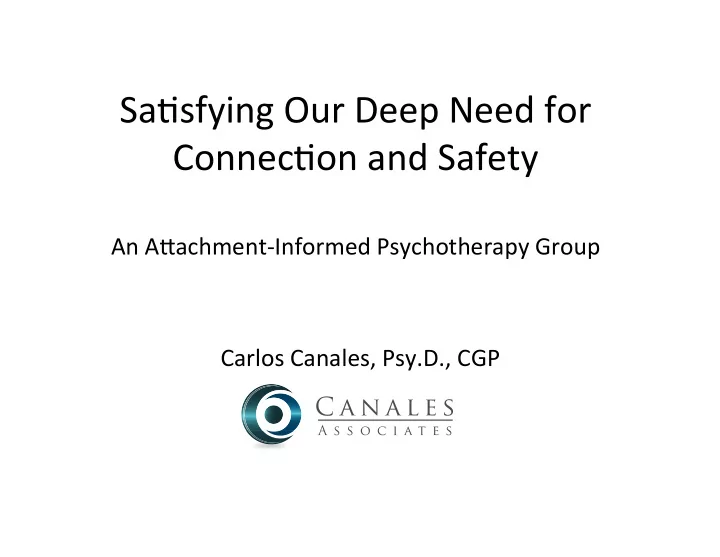

Sa#sfying Our Deep Need for Connec#on and Safety An A8achment-Informed Psychotherapy Group Carlos Canales, Psy.D., CGP
Why groups? • The group as microcosm • Exposure and resolution of human dilemmas – Intimacy issues, interpersonal • Live practice - rewiring the brain • Learning new behaviors, learning about feelings • Exposure to multiple perspectives • Provide a corrective experience
Interpersonal learning Yalom’s Installation of Hope Therapeutic Factors Group cohesiveness Universality Catharsis Altruism Imitative Imparting behavior Information Recapitulation of the Existential Development of primary family group factors socializing techniques
Why study groups? Counselman 2008 • Presence in the here-and-now • Comfort with affects in the room • Closeness and separateness • Empathic connec#ons • Sensi#vity to shame, envy, jealousy, rivalry… • Explora#on of resistance • Difference in communica#ng • Awareness of group dynamics
A word on culture • Culture of independence - “me do it” • Culture of dependency – “what should I do” • Culture of secrecy - “what happens in the family...” • Culture of words - ”swearing,” idioms • Culture of Timing - Absences, timeliness • Culture of participation
Evolu#on of Psychotherapy Classical Contemporary • Conflict and ego/wishes • Deficits and self/needs • Attachment &rel • Drives and ins#ncts • “tragic man” • Guilty man • Two person psych • One person psychology • Intersubjective • Intrapsychic • Therapist • Therapists abs#nence engagement • Dispassionate guide • Participant observer • Opaque • Presence • Interpreta#on and • Relationship and understanding empathy
Why a8achment-based treatment? • Crea#on of a progressive more secure rela#onship • …facilita#on and strengthening of adap#ve capaci#es by addressing the emo#ons and the communica#ons that the pa#ent has learned to suppress or to overemphasize in early a8achment rela#onships.
A8achment Theory • Simple • Norma#ve • Normalizing • Developmental • Pathology informa#ve • Systemic • Sustaining • Depth oriented • Compa#ble with Neuroscience
Characteris#cs of An A8achment Figure Mary Ainsworth 1. We monitor emo#onal and physical closeness Proximity seeking. 2. We reach out when we are uncertain or upset. Safe haven. 3. We miss them when they are distant. Separa6on is distressing 4. They have our back. Secure base
Bartholomew and Horowitz's model 10
Characteris#c of A8achment Figure Mary Ainsworth 1. We monitor emo#onal and physical closeness with our loved one. Proximity seeking. 2. We reach out for our a8achment figure when we are uncertain or upset. Safe haven. 3. We miss them when they’re physically or emo#onally distant. Separa6on is distressing 4. We rely on them to back us when we go out into the world. Secure base
Secure A8achment Personally Interpersonally Body Regula#on Disclose well, open Tolerates conflict A8unement Express nega#ve Emo#onal Balance transference Response Flexibility Be8er caregiving to others Soothing Fear More empathic Insight Forgives more easily Empathy Reflec#ve capacity Morality ABLE TO FEEL AND DEAL
• Flooded with emo#ons • More self cri#cal • Seek out praise and caregiving from others • Less empathic • Difficultly forgiving • More jealous and preoccupied with other • Sensi#ve to abandonment and rejec#on • FEEL BUT NOT DEAL (Fosha, 2007 )
• Values independence and achievement • Devalues dependency and vulnerability • Tend to prefer thinking to feeling • uncomfortable with group cohesion • Poor memories of childhood • DEAL BUT DON’T FEEL (Fosha, 2007)
• Engage in both avoidance and hyperac#va#on • Concerned with safety • May dissociate to cope with pain/ distress • Fearful of abandonment and rejec#on • Pull away from others • Ofen history of trauma • Can’t FEEL OR DEAL (Fosha, 2007)
For the Client For the clinician • An understanding of how an • Increases our apprecia#on individuals’ IWM of self, and empathy for resistance others, and groups develop as an adap#ve strategies over a life #me and influence current rela#onships • Increases our insight into different goals some • An understanding of how one members may have and how is able to be vulnerable, members may influence one regulate emo#ons, and another empathize with others • Facilitates our understanding of what group is best for an individual
Features of A8achment-based Therapy • Access of emo#ons • Use of dyadic affect regula#on strategies • Explora#on of context • Value of defenses • A deep priori#zing of bo8om up processing
Segng the culture of group: the group’s rela#onship to the leader PDR Model for • Safety and care • Presence and availability • Containment and holding • Interven#on • Self reflec#on Making the group relevant
Recommend
More recommend